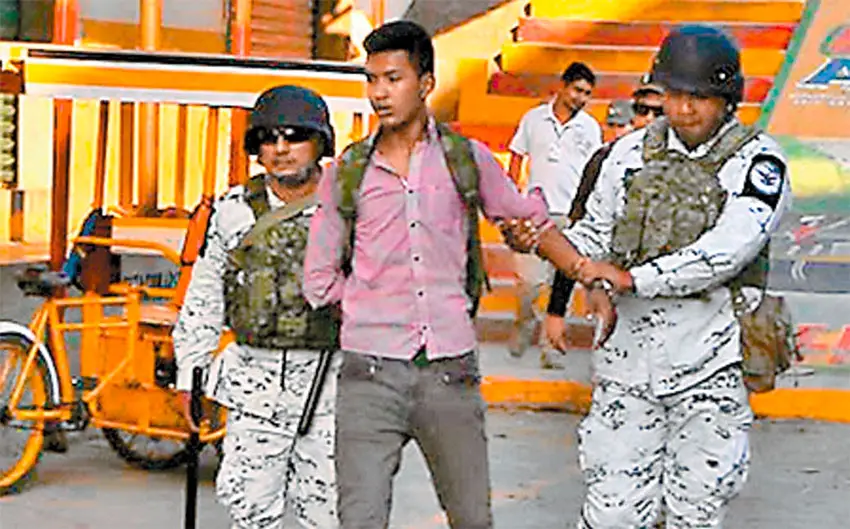The National Guard used tear gas and batons to repel hundreds of Central American migrants attempting to enter Mexico by wading across the Suchiate River on Monday, but hundreds more successfully entered the country, although the majority were quickly detained.
Taking advantage of low water levels, about 800 migrants decided to cross the river between Tecún Umán, Guatemala, and Ciudad Hidalgo, Chiapas, at midday yesterday, the newspaper Milenio reported.
The decision came hours after the National Guard stopped a contingent of some 3,000 mainly Honduran migrants from entering Mexico via the Rodolfo Robles bridge.
As they approached the Mexican side of the river, migrants began throwing rocks and sticks at the guardsmen and immigration agents who were awaiting them. The Mexican forces responded to the aggression with tear gas but the majority of the migrants continued to make their way across the Suchiate.
Confronted with a wall of baton-wielding police, hundreds of migrants decided to return to Guatemala after reaching the river bank but some 500 others managed to push their way through the Mexican forces to reach Ciudad Hidalgo. Five members of the National Guard were injured in the confrontation and received treatment in local healthcare centers, Milenio said.

The migrants who broke the Guard’s defenses left Ciudad Hidalgo on foot via a federal highway that connects the border to Tapachula, located about 40 kilometers to the north. Another large group of migrants stayed the night on the riverbank on the Mexican side under the watchful eye of guardsmen and immigration agents, the newspaper Reforma reported on Tuesday.
The National Immigration Institute (INM) said in a statement that its agents, supported by the National Guard, “rescued” (a euphemism for detained) 402 migrants who had entered Mexico illegally. Milenio reported that they were detained at a police checkpoint six kilometers from Ciudad Hidalgo.
The migrants were transported to immigration facilities where they were provided with accommodation, healthcare, food and water, the statement said.
The INM said that 40 migrants decided to return to Guatemala, while immigration agents are searching for 58 others who evaded authorities by fleeing via “unsafe paths in the region’s jungle area.”
Those already detained will be assessed by immigration personnel to determine their legal status and if they are not found to be genuine refugees, they will be returned to Tegucigalpa, Honduras, either by government planes or bus, the INM said.
The institute said Sunday that it expected that the majority of 1,087 migrants detained over the weekend would also be deported although the government has said that jobs in government employment programs will be on offer in Mexico’s southern border region for genuine refugees.
However, most migrants have indicated that they intend to travel to the northern border to seek asylum in the United States and have demanded the government issue them with transit visas to allow them to travel through Mexico legally.
But facing pressure from the United States government to stop migrant arrivals, Mexican authorities have made it clear that they will not issue such visas.
The government has increased enforcement against migrants since United States President Donald Trump threatened in the middle of last year to impose blanket tariffs on Mexican imports if the country didn’t do more to halt migrant arrivals to the Mexico-U.S. border.
The deployment of the National Guard at Mexico’s southern and northern borders last year triggered claims that Mexico had in effect become Trump’s long promised border wall.
Speaking to reporters at his morning news conference on Tuesday, President López Obrador defended the use of the new security force, asserting that it is currently at the southern border to uphold Mexican laws “without violating human rights.”
Many migrants are determined to avoid registering their entry to Mexico with authorities because they believe that it will only result in them being returned to the countries they fled.
However, López Obrador claimed that the purpose of registration is to protect migrants from harm’s way.
“. . . If we don’t know who they are, if we don’t have a record, they pass [through the country] and reach the north [where] they’re caught by criminal gangs and attacked . . . That’s the way it was before, they disappeared them [the migrants].”
